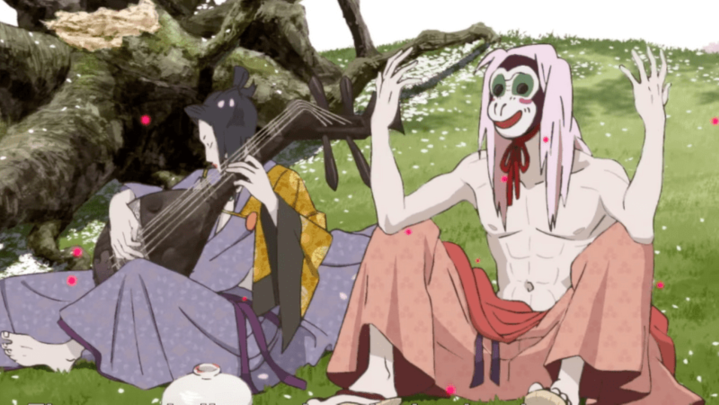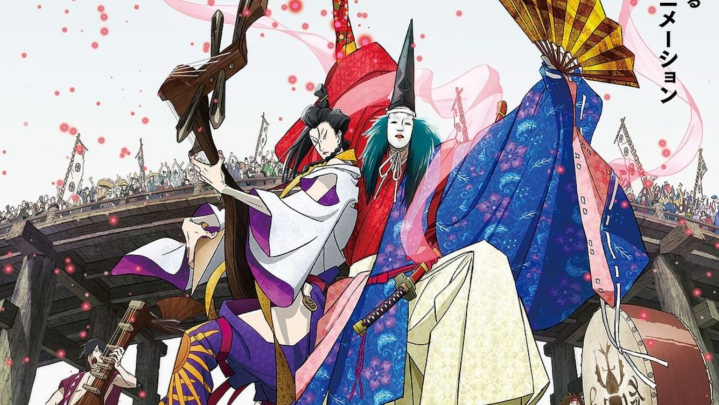Rock musicals admittedly aren’t one of the things that fans of the genre typically watch anime for. However, even though director Masaaki Yuasa’s (The Tatami Galaxy, Ping Pong the Animation) Inu-Oh won’t be taking the spotlight off other conventional movies coming out this year, like Dragon Ball Super: Super Hero or One Piece Film: Red, it’s certainly one that deserves the attention of anime enthusiasts.
Inu-Oh is an artistic, creative, and stylized tale of alternate history, and while its story isn’t heavily dialogue-driven in a typical sense, the blend of the rock opera musical genre, the 14th-century setting, and animation studio Science SARU’s mesmerizing art direction come together wonderfully to present some resonating themes and emotional resolutions.
Saying more with less

Inu-Oh is an adaptation of author Hideo Furukawa’s novel Tales of the Heike: INU-OH, and its combination of revisionist history and rock operas prove to be one of the most ingenious premises in an anime release this year. It follows the story of Tomona, a young man and biwa player blinded as a child who loses both of his parents. He goes on to meet the titular Inu-Oh, another young man born of severe deformities as a result of a cruel curse. Together, the two go on to countrywide stardom as they combine their musical talents and penchant for theatrics.
The movie isn’t heavy on dialogue, but the story speaks volumes without being too overt or melodramatic — something that anime is occasionally guilty of. And, as one would expect, a lot of the story and world-building is presented through rock musical numbers. However, the cast up and down does excellent work of conveying charged emotions in the character interactions.
It’s a sort of story within a story, as the vehicle for the plot centers around speaking the truth through storytelling in the face of authoritative suppression. Its socially conscious themes of giving a voice to the marginalized, embracing change while rebelling against rigid tradition, and how history is “written by the winners” are impressively poignant.
Watching Tomana and Inu-Oh perform with such passion makes the movie as a whole feel like a thunderous anthem and rallying cry, drawing meta parallels with the world today. And even with those larger societal topics touched on throughout Inu-Oh, it also doesn’t lose sight of the personal journeys of its two heartfelt protagonists breaking down social norms.
Hypnotic art direction and animation

In addition to the writing and directing being narratively efficient, studio Science SARU’s (whom Yuasa has also worked with extensively before) work on Inu-Oh was the other crucial half of telling a story that heavily emphasizes visual presentation. The studio’s animation and overall art direction is something akin to what fans of their work on Ping Pong the Animation would be used to.
The style is hypnotically surreal and unique when compared to other anime TV series or movies, especially for how it balances that surrealism with a somewhat grounded setting. Both of these artistic styles were important to mesh together effectively, since this revisionist history story/rock opera has an essential element of fantasy and magical realism embedded into it.
The cruel world that Tomona and Inu-Oh have to wade through and the unfair circumstances of the lives they lead are what bring about the movie’s more colorfully vibrant aspects. From their perspectives, that vibrancy is in perfect contrast to the comparatively dreary and gray world stuck in place on the outside. It’s all in all an impressive feat of visual harmony.
Likewise, how well the animation of facial expressions is done can’t be stressed enough. Especially during the musical segments, the animation perfectly conveys a spectrum of emotions in excruciating detail, from anger to passion to apathy and sorrow, which is incredibly fitting in a story that’s ultimately about rebellion, truth, and emotional expression through music.
Refreshing originality

Anime like Dragon Ball, One Piece, Jujutsu Kaisen, and other similarly action-focused shōnen anime understandably take the lion’s share of the limelight in this genre. Some of those are admittedly beloved for flipping certain demographic tropes and/or immersive storytelling and world-building, but anime like Inu-Oh are great palette cleansers for how conceptually inventive and down-to-earth they feel.
With its strangely seamless combination of anime, historical fiction, fantasy, and rock opera genres, Inu-Oh injects an exciting and refreshing dose of originality into a segment of the entertainment industry that, as with several others, sometimes feels like it’s too saturated and spreading itself thin creatively.
It isn’t a massive franchise/IP endeavor meant for mass-market appeal, but everything down to the direction, cast performances, and otherworldly animation looks lovingly made.
And, as an anime movie specifically, it does a great job of standing on its own as a complete story that is uncompromising in presenting its vision. Even though it might have afforded to pad out its runtime slightly to expand on the main and supporting characters’ lives more, the brisk pace and colorful depiction of history are effective enough to overlook this flaw.
Inu-Oh also succeeds in being one of those select anime that audiences otherwise uninitiated in the genre could watch and appreciate on its own artistic merits. All the movie’s moving pieces work together to visualize a world that’s creative, immersive, thematically rich, and aesthetically unique. It isn’t your typical anime fanfare, but that’s for the best in this case, as Inu-Oh does well to stand apart in a densely packed genre.
Director Masaaki Yuasa and animation studio Science SARU’s Inu-Oh is playing in theaters starting August 12.
Editors’ Recommendations
Credit: Source link


Comments are closed.